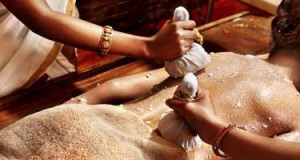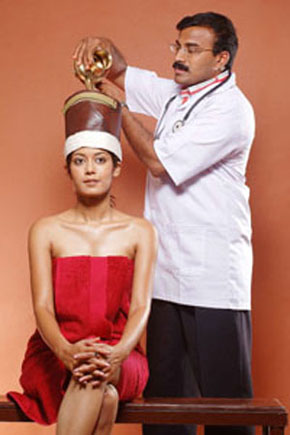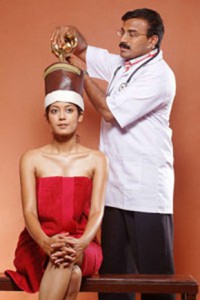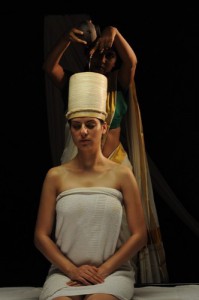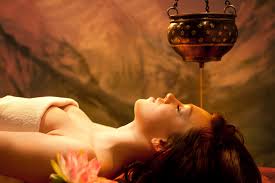
Sirodhara is the process in which medicated oil, milk, butter milk or Kwatha is poured in a continuous stream of drip on the head, especially on the forehead. Depending on the drug components, Dhara is known by different names like Takradhara, Kshira Dhara, Taila dhara, Kwatha Dhara, Jala Dhara
Synonyms:- Dhara, Seka, Parisheka, Avasheka, Secana, Prasecana
Introduction: Pouring of a liquid over the forehead or scalp is known as Shirodhara. It can be done by different medicaments like Taila, Takra, Kshira, Kwatha, etc. When it is done with medicated Ghee or Taila, it is called Taila Dhara which is commonly called as Shirodhara. It is one among the four types of Murdha Taila procedures. Murdha Taila means application of medicated oils over the head in different forms. Dhara means a continuous flow of liquid from the hole of the pot.
Benefits: Shirodhara by using medicated oil or ghee will enhance the firmness of mind and speech, strength of the body, inclination to food, makes the skin healthy, enhances the sharpness of eyes, virility, semen and blood and promotes longevity. It reduces the excess body temperature and induces good sleep.
Materials required: Droni, Dhara pot, wick, rope, cloth, Hotwaterbath, vessels, medicated oil, blanket or bed sheet and Amalaki powder for Taladarana.
Selection of Drugs for Shirodhara: Drugs used for Shirodhara should be selected on the basis of the nature of the disease, vitiated Dosha as well as the constitution of the biological strength of the patient. Drugs specifically indicated in certain disease are-
- Vataja Roga – Bala Taila, Dashmool Kwath, and Ghrita etc
- Pittaja Roga – Chandana, Usher Kwatha etc
- Kaphaja Roga – Naagara, Mustaka and Madhuyasti Kwatha
According to Dhara Kalpa, Sneha is selected as per the condition of Dosha which is mentioned below.
- Vata Dosha – Tila Taila
- Pitta Dosha – Ghrita
- Kapha Dosha – Tila Taila
- Rakta Dosha – Ghrita
- Vata + Pitta + Rakta – Ghrita + Taila in equal portion;
- Vata + Kapha + Rakta – ½ part Ghrita + 1 part Tila Taila
The quantity required is about 2 to 3 liters.
Indications: This Shirodhara is indicated in the diseases like Ardhavabhedaka, Suryavarta, Ardita, Pakshaghata, Hanugraha, Akshi Shoola, Nidra Nasha, Shiro Gata Vata and Shira Kampa. Nowadays, it is indicated in almost all stress and psychosomatic disorders such as IBS, Asthma, neurological disorders viz. headache, epilepsy, and psychiatric disorders like psychosis, neurosis, insomnia and also in psoriasis, eczema, anxiety neurosis, other psychological illness, sleeplessness, hypertension, headache, migraine, paralysis, premature graying of hair and premature baldness, stress related conditions.
Contraindications: In Kaphaja diseases if Shirodhara is practiced then it further increases Kapha, which makes the disease difficult to cure.
Preparation of patient: Shirodhara is done in the morning or evening on empty stomach after proper massage. Shave the head or in case of women tie the hair tightly so that oil reaches all parts of scalp. The patient should pass stool and urine. Then patients pulse, temperature and blood pressure should be recorded. The patient is asked to lie down on the massage table in supine position. Apply little oil over head and body. Do Abhyanga for 5-10 minutes. Tie a band of cloth over forehead above the ears and eyebrows. The band should be round in front and flat at back. Tie the knot at one side of head. A cushion pad is kept beneath the neck of the patient so that the head of the patient gets tilted slightly backwards. The eyes are covered with cotton pad and may be lightly bandaged so that liquid doses not enter the eyes of the patient.
Materials required:
- Shirodhara device-1
- Varti- 1
- Suitable oil-1.5litres
- Gauze- 1
- Cotton earplugs-2
- Soft pillow covered with rexin-1
- Hotwaterbath-1
- Vessels -3
- Nadisweda device-1
- Oil for Talam-10ml
- Rasnadi choorna- 5g
- Soft towels-2
- Dhara patra-1
- Attendents-2
Specification of Dhara patra and varti:
Dhara patra should be 5-6 inches depth with wide open mouth, round at the bottom with a capacity of approximately 2 litres. There should be a hole to the size of little finger at its centre of the bottom. There should be three holes with equal distance to the ridges of the patra, to tie up three strings for the purpose of hanging over the stand.
Dhara varthi is a wick or a string of loose cotton threads with a free end of about 4 inches coming out through the hole of dhara vessel. The threads of the wick should be packed only just firmly as not to slip of the hole, but loose enough to permit a continuous and uniform flow of the liquid that is poured in to the dhara vessel.
Pre operative procedure:
Abhyanga should be done over the face, neck, shoulder and chest.(Whole body abhyanga can also be done) Gauze is tied around the head above the eyebrows of the patient. After closing the eyes cotton is kept over the eye lids and it should be tied with proper bandage. Ear plug should be applied.
Procedure:
Patient should lie in supine position on the droni with a pillow under the neck and the shirodhara device should be placed near his head .Eyes should be covered to protect from oil with cotton and gauze. Its height should be fixed such that oil should fall from a height of 4-5 inches in a continuous stream of little finger thickness. Serrated coconut shell should be placed inside the apparatus to maintain uniform dhara. Oil should be heated just above body temperature(38- 40oC) and poured into the dharapatra . A continuous stream of oil should be allowed to fall on the entire forehead, while oscillating the dharapatra to coverb the entire head…Uniform oscillation is required for uniform dhara .Simultaneous massage with other hand should also be done.
The oil should be recollected from the droni, reheated and poured back into the dharapatra.
For this procedure a specific table having seven feet length, two and half feet breadth and two and half feet height is required .It must have a slope and a hole toward head side for the collection of the liquid and provision to keep the head of the patient comfortably. For filling the liquid a Dhara Patra is taken which is a round vessel prepared from brass, steel, clay etc The mouth of the vessel should be wide and sides are tapering gradually to a ventral point in the bottom. At this point a hole may be made approximately of little finger size. The depth of vessel may be 5 to 6 inches. The capacity of the vessel may be 2 Prastha (1.5 – 2 liters). Inside the vessel a small wooden bowl having a central hole should be put inversely so as to both holes of the vessel come in the medial line. In this small vessel a wick should be entered passing through the both holes and hanging down from the big vessel so as to maintain a continuous flow of liquid. The length of the wick outside the vessel should be 4 inches. The upper end of the wick should have knot to prevent slipping from the vessel. The Dhara Patra should be hanged just above the forehead of the patient. The end of the wick should be 4 fingers (3 inches) above the forehead of the patient. The vessel is kept refilled with the recollected liquid. On the upper edge of the vessel, 3 holes should be made to hang it in a horizontal plane to
avoid spillage.
Take the selected medicated oils like Himasagara Taila, Ksheerabala Taila or Brihat Masha Taila etc. in a vessel. Oil should be heated just above body temperature (38- 40oC) and collected in Dhara Patra. Start pouring the oil continuously and slowly from 4-inch height over the forehead. A mild oscillation should be given to maintain the flow all over the forehead. The oil should be recollected from the Droni, reheated and poured back into the Dhara Patra and continue the procedure.
After Care:
Gauze and earplugs should be removed and head must be wiped off with the towel. Rasnadi choorna should be applied over the head. Hot water bath can be done if prescribed, after 1 hour. Give some rest to the patient .At last advice him to take hot water bath. The water boiled with coriander seeds and ginger is prescribed to drink.
Duration: It should be done for 53 minutes and for 7-14 consecutive days. The patient having dryness and Pittayukta Vata, the period is 2½ Prahara or 2 Prahara and in Snigdha Kaphayukta Vata it is one Prahara, or it should be upto perspiration initiate. The patient has to remain in the laying posture on his back. The treatment may be carried on daily for a period of 7 to 14 days, according to the nature of the disease and the physical condition of the patient. Generally treatment is done in the morning hours preferably between 7 to 10 am.
Diet and Advise: Advice the patient to take rice gruel and light diet. In the days prior, during and after the procedure, one has to consume that quantity of food which gets digested properly. The hot rice should be given with the soup of greengram or hot Vilepi. The food should not be Abhishyandi i.e. it should not increase Kapha. He should drink water, which is prepared with Vata pacifying drugs. He should take Pathya up to 7 days. For drinking purpose warm water boiled with Dhanyajiraka, ginger and cumin seeds may be used. For washing and ablating purposes only warm water should be used. Avoid hard work and activities. Exposing to cold weather and taking cold items during the procedure is strictly prohibited. The patient should abstain from sexual intercourse as well as from any thought or deed that may excite sexual desire, avoid physical exertions, mental excitement such as anger, grief etc. and exposure to cold, sun, dew, wind, smoke or dust should also be avoided. Riding on elephants or horses, walking, speaking too long or too loud and such other acting that may give any strain to the system must be avoided. Sleeping during daytime and standing continuously for long period must also be avoided. It is also advisable to use a pillow which is neither very high nor very low, during sleep at night. During the course of the treatment, the patient should be cheerful and happy and should avoid wearisome exertions, distasteful diet or excessive indulgence in tasty foods. He should wear clean and dry cloths and may have anointed with sandal wood paste.
Precautions: During the process if headache, giddiness and burning sensation of the body are observed then we have to reduce the height of Dhara. If Dhara is done from more height, very early or very slowly then it may produce burning in body, pain in all joints, bleeding tendency, fever etc. For the treatment of this Dhara Dosha, following measures may be adopted.
1) Gandusha
2) Nasya
3) Kashaya Pana with Sunthi
4) Light diet at evening, Yusha with black pepper.
5) On the third day Basti should be given in which Saindhava is mixed.
Practical tips: It is the most important point that Shirodhara should be performed in a very peaceful and pleasant atmosphere to get the maximum benefit of therapy.
The same temperature, force and continuous flow should be maintained throughout the procedure. Moderate height, thickness and speed should be maintained. Patient should not sleep during the process.
In Kevala Vata conditions, oil should be bearably hot, in Pitta conditions, slightly warm and in Kapha conditions oil should be heated till the substance just melts and in the diseases above the clavicle it should be cold.
Period for changing the liquid: When milk is used for Parisechana it should be changed every day. When Dhanyamla is used, it can be used up to 3 days. Oil also should be changed at 3 days. In the first 3 days; half of the oil used, for next 3 days later half of its used and on the 7th day all the first and second half are mixed together, then it should be discarded.
Mode of action: Shirodhara as it comes under Bahya Snehana, which produces viscosity, softness, solubility and Kleda in the body. Continuous pouring of oil on fore-head for a specific period has tranquilizing effect and induces sleep. As per modern science, local application as ointment may pass through the stratum corneum into blood vessel and producing desirable effects by reaching the target organ. The continuous pouring of oil in relaxed and comfortable position has an additional effect which can be comparing to cradling of mother to a child. This function acts as sedative and soothing effect for the brain and produces sleep. Oil poured on fore-head may be absorbed; producing Tranquilizing effect by reaching the Brain cortex.
The chemical constituent of medicated oil may act as a Neuro transmitter as deficiency of certain Neurotransmitter can be checked hypothetically if oil percolates in to Brain cortex while treating the patient of Angina by Nitroglycerine.
As Tila Taila is Vatahara and Snigdhata, properties help Tarpaka Kapha in proper facilitation and sound connection of Indriyas and their Vishayas which was deranged earlier by aggravated Vata. Active ingredients of oil penetrate into the circulation via for- head and produces Vatahara effect. However oil produces lubrication and nutrition. Shirodhara acts as Medhya if oil which is used is processed with Medhya drugs.
According to Dhara Kalpa, the time required for the medicinal potency of the oil which is used for Shirodhara to traverse through the body elements is mentioned. The unctuous substances after laying over the hair follicles for a period of 300 Matra Kala, enter the skin by 400 Matra Kala; in the similar manner the unctuousness reaches Rakta, Mamsa, Meda, Asthi and Majja in each successive 100 Matra Kala i.e. it reaches Majja by 900 Matra Kala. It is mentioned in the classics that potency of the drug reaches Shukra by 1600 Matra Kala. The medicinal potency, during the course of successive transference, reduces the disease of Vata, Pitta and Kapha located in the respective body elements.
Effect on Marma:
- Sthapani Marma: Just below this area inside the skull lies the venous reservoir of the brain the superior Sagittal and Cavernous Venous Sinuses.
- Shankha Marma: It corresponds to temporal bone of the skull underneath which lies the temporal lobe of cortex arterial branches and at the base is also some of the important structures of the brain.
- Utkshepa Marma: Intracranial cavity and venous sinuses the wall of which are made of coverings of the brain lie in this region
- Adhipati Marma: This location is well known as the anterior fontanelle on the vertical groove of the frontal bone. Underneath this point, there is sagital sinus of the brain and also the sulcus between two hemispheres of the cortex.
Shirodhara stimulates these Marma’s and improves circulation, as oil used for Shirodhara is always warm which causes vasodilatation of all the channels and thereby improving their circulation which in turn improves the blood circulation of brain. This improves the higher intellectual functions also. So an improvement in psychic symptoms is achieved. Improvement in circulation to hypothalamus also improves the function of Autonomic Nervous System as its stimulation during stress causes many physiological disturbances.
Effect on Chakras: Shirodhara stimulates Agnya Chakra thereby improving the functions of mind which is vitiated in Stress as it is the place of subtle mind. Structures like Pituitary gland, pineal body, subcortic structures of mid brain are related with mental functions like anger, grief, pain, fear, memory and other higher intellectual functions .Shirodhara acts at this level correcting their functions.
Effect on Central Nervous System: The Shirodhara procedure and various drugs used for it, can affect the Central Nervous System in the following ways:
· They may act directly on neurons and modify the neuronal functions.
- They may act reflexly by sending afferent impulses to the central nervous system via the chemoreceptors, baroreceptors and peripheral nerves and there by eliciting psychic, somatic or visceral responses.
- They may affect the nutrition and oxygen supply of the CNS by altering its blood supply or affecting its metabolism.
To reach the central nervous system, a drug must have a high degree of lipid solubility (high oil / water partition coefficient) or a specialized transport mechanism. Ionized drugs as a rule cannot penetrate into the central nervous system. For this reason the existence of a blood brain barrier has been postulated. Drugs may either stimulate or depress the central nervous system.
Basis of drug action:
- a) Drugs may modify the synthesis, storage, release or metabolism of the inhibitory or excitatory Neuro-chemical transmitters. Thus, monoamine oxidase inbitors act as antidepressants by inhibiting the destruction of noradrenaline by the enzyme, Mono Amine Oxidaze (MAO) the transmitter dependent actions of drugs can be classified into pre-synaptic and post – synaptic.
- b) Drugs may modify the energy supply of the central nervous system. This may be achieved by local inhibition of the Synthesis of high energy phosphate bonds (barbiturates), by inhibition of action of certain enzymes involved in cellular respiration and energy processors or by increasing or decreasing the availability of the substrate for energy production.
- c) Drugs may act by modifying ionic fluxes across the cell membrane.
- d) Drugs may specifically acts as antagonists of other drugs at receptor levels. It is extremely difficult to define what constitutes psyche or ‘mind’ which is supposed to carry out three functions.
- Reception of environmental stimuli (cognition)
- Analyzing the information received and formation of a reaction pattern (affect)
- The actual behavioral response (conation)
The exact site and mode of action of various psycho-therapeutic agents therefore remain unidentified. By affecting three of the major integrating systems of the brain firstly, they may reduce the incoming sensory stimuli by acting on brain stem reticular formation. The drugs also modify the function of limbic system. Lastly they are known to cause blockage of post synaptic Monoaminergic (noradrenalin, dopamine and 5-hydroxy tryptamine) transmission in the brain, thus leading to a decrease in the central sympathetic activity.
Effect on Autonomic Nervous System: Shirodhara may also have Alpha Adrenergic blocking effect and can thus block certain actions of adrenaline and nor adrenaline. Shirodhara may also act on the adrenergic neuron probably produce their effects by modifying the synthesis storage and uptake mechanisms of noradrenaline.
Effect on Endocrine system: The effect of Shirodhara on hormone secretion can also be postulated considering the effect on hypothalamus as hypothalamus is the main controller of endocrine secretions. The hypothalamic Neurons which secrete the regulatory hormones are themselves under the control of specialized Monoaminergic, neurotransmitter neurons which arise in the mid brain where these latter releases Dopamine, Noradrenaline and Serotonin. In turn, these mid brain nuclei are under the control of visceral brain and are responsive to stress and emotional disturbances.
Regulation of emotional and behavioral patterns: Together with the limbic system with the hypothalamus regulates the feeling of rage, aggression, pain and pleasure and behavioral patterns of sexual arousal ultimately it can be postulated that Shirodhara may be having some effect on hypothalamus resulting in decrease of most of the psychic and somatic disorders.




